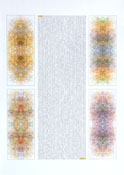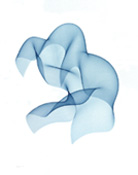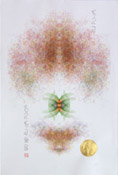|
<< Archive Menu | History | Main Menu | Search | Contact |
|||
| Documentation
for Roman Verostko's participation
algorithmic drawings |
|
||
 |
Illuminated Universal Turing Machine,
30" by 44", 1995. Algorithmic pen and ink drawing with gold leaf
enhancement. The central area
displays a number that is the code for a Universal Turing
Machine (UTM). This version, in expanded binary, is quoted from Chapter
2 of the The Emperors New Mind by Roger Penrose. This number is an algorithm, in
expanded binary, for a UTM. In the
tradition of illuminated manuscripts this algorithm is
presented as a highly treasured text that has played a seminal role in
the birth of 20th Century computers. The form enhancements
celebrating the algorithm are generated with the artist’s
code that requires the logic of a UTM for
its execution, thus being a form of “Turing on
Turing”. The Project: This is one of several families of algorithmic pen plotted drawings presented as illuminations of the Universal Turing Machine code. These drawings, as in medieval illuminations, celebrate Alan Turing's historic work with universal problem solver procedures. For a cyberspace version presented as a self portrait click here. |
||
 |
Cyberflower VII, Algorithmic pen & ink drawing, 2000. 23" by 30". The cyberflower series demonstrates that a new frontier of form emerges for artists who create original form generators | ||
 |
Ezekiel Series IV, Algorithmic pen & ink drawing with gold leaf enhancement, 1996. 30" by 44". | ||
 |
Two Thousand Improvisations, Celebrating 2000 years, Algorithmic pen & ink drawing, 1999. 24" by 40". These improvisations, celebrating 2000 years, were begun in 1999. Three series with various versions have been drawn. Each version presents a different series of two thousand improvisations, each individually drawn with pen and ink, line for line, without any repetitions. The detailed originals can be hypnotizing as the eye wanders from one unit to the next discovering unexpected form inventions from one rectangle to the next | ||
|
Display Case
|
Derivation of the Laws. . ., by George Boole with algorithmic illustrations by Roman Verostko, a limited edition, Minneapolis, 1990. Display. Display shows 5 original books from the limited edition and 1 copy of the reproduction edition of The Derivation of the Laws by George Boole. Four of the books are opened to show the pen and ink drawings that were made individually and tipped in as front and end pieces for each book. The 5th book shows a text page with an illustration achieved with line cut plates made from algorithmic drawings. Text. The text is Chapter III from Boole's Classic work, An Investigation of the Laws of Thought... (Macmillan, London, 1859). This edition includes a Preface by Roger Malina, a statement by Roman and a Postscript. Frontispieces
& Endpieces.
For this edition 125 original front and end-pieces were created in the
artist's studio. Each frontispiece was drawn and brushed, stroke for
stroke, with Verostko's coded procedure guiding the drawing arm of a pen
plotter. This edition
exemplifies a radical new procedure whereby the same "parent"
code, created by the artist, generates a series of original drawings.
Each drawing, in this family of forms, bears a familial resemblance to
the others. This edition (1990) may be the first instance where an
algorithmic improvisational series of original drawings was created for
a bound limited edition. Other illustrations: For the illustrations accompanying the text the artist created algorithmic drawings in four colors. Using the master code he cloned each color in a separate drawing using black ink. From these drawings four line cut zinc plates were made for each color illustration. Rationale. This
edition was created as a tribute to the 19th Century
mathematician George Boole (1815-1864). Boole’s treatise on the Laws
demonstrates the direct link between Aristotle’s principle of
contradiction and the symbolic logic known today as Boolean Algebra.
Boolean logic, a symbolic language seminal to the development of
modern circuit boards, is fundamental to programming languages. The
illustrations for this edition, generated with principles outlined
in Boole’s Laws, exemplify the profound kinship emerging today between
art and coded procedure. Edition. The limited edition of 125 copies, bound in leather, was pulled by hand at the St. Sebastian Press in Minneapolis in 1990. The type, Gill Sans, cast by M&H Type of San Francisco, is printed on Frankfurt text, with Kohl & Madden inks, by Michael Tomaszewski. The work was also issued in a reproduction paperback version based on the original type setting and plotter drawings (February 1991, ISBN 1-879508-07-9). The press is no longer active. The artist retains a limited number of copies of each edition |
||
|
<< Archive Menu | History | Main Menu | Search | Contact |
|||





